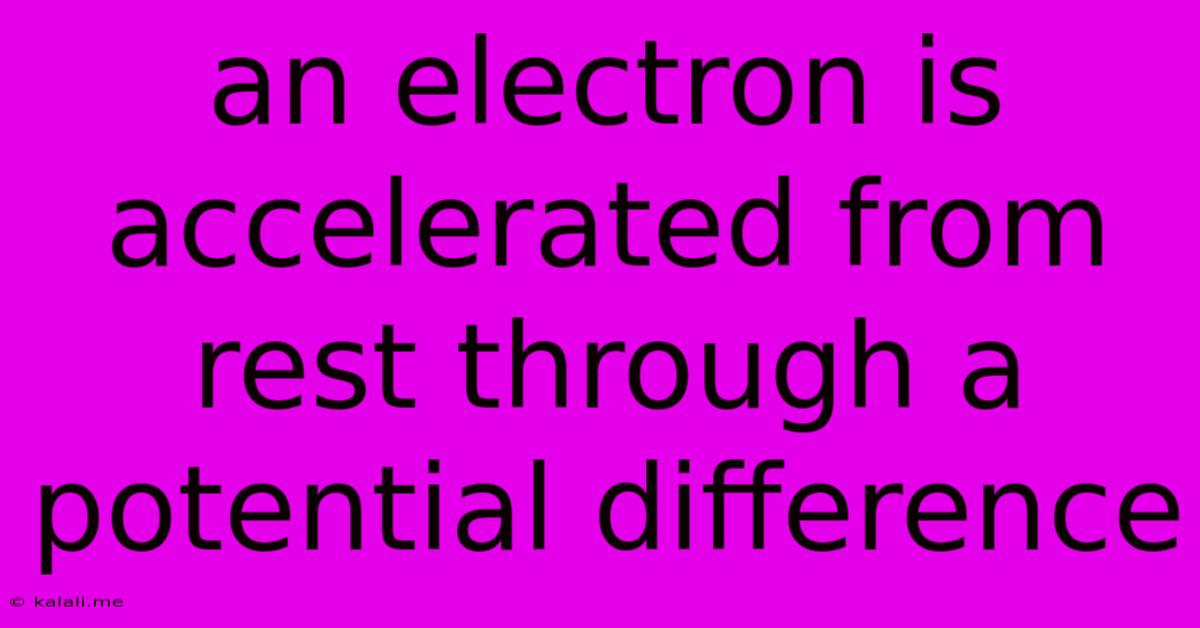An Electron Is Accelerated From Rest Through A Potential Difference
Kalali
Jun 14, 2025 · 3 min read

Table of Contents
An Electron Accelerated Through a Potential Difference: Understanding the Physics
Meta Description: Explore the physics behind an electron's acceleration through a potential difference. Learn about the relationship between potential difference, kinetic energy, and electron velocity, with clear explanations and practical examples.
When an electron is released from rest and accelerated through a potential difference (voltage), it gains kinetic energy. This seemingly simple scenario is a fundamental concept in electromagnetism and has numerous applications in various fields, from particle accelerators to electron microscopes. This article will delve into the physics behind this phenomenon, explaining the key relationships and calculations involved.
Understanding Potential Difference and Electric Fields
A potential difference, often measured in volts (V), represents the work done per unit charge in moving a charge between two points in an electric field. An electric field exerts a force on charged particles, causing them to accelerate. The stronger the electric field (higher potential difference across a shorter distance), the greater the acceleration. In the case of an electron, which carries a negative charge, it will accelerate in the direction opposite to the electric field lines.
The Relationship Between Potential Difference and Kinetic Energy
The key principle governing this acceleration is the conservation of energy. The potential energy lost by the electron as it moves through the potential difference is converted into kinetic energy. This relationship is expressed mathematically as:
ΔPE = -qΔV = ΔKE
Where:
- ΔPE is the change in potential energy
- q is the charge of the electron (approximately -1.6 x 10⁻¹⁹ C)
- ΔV is the potential difference (voltage)
- ΔKE is the change in kinetic energy
Since the electron starts from rest, its initial kinetic energy is zero. Therefore, the final kinetic energy is directly equal to the magnitude of the change in potential energy.
Calculating the Final Velocity of the Electron
The kinetic energy of the electron is related to its velocity (v) by the following equation:
ΔKE = 1/2 mv²
Where:
- m is the mass of the electron (approximately 9.11 x 10⁻³¹ kg)
- v is the final velocity of the electron
By combining the two equations above, we can derive an expression for the final velocity of the electron:
v = √(2qΔV / m)
This equation allows us to calculate the final velocity of the electron after it has been accelerated through a known potential difference. It's crucial to note that this equation is derived under the assumption of a non-relativistic scenario. At very high potential differences, relativistic effects become significant, and a more complex calculation is needed.
Practical Applications and Considerations
The acceleration of electrons through potential differences is a crucial principle in many technologies:
- Electron Microscopes: These utilize high-voltage potential differences to accelerate electrons to high speeds, enabling high-resolution imaging.
- Cathode Ray Tubes (CRTs): Although largely obsolete, CRTs relied on accelerating electrons to produce images on a screen.
- Particle Accelerators: These massive machines accelerate charged particles, including electrons, to extremely high energies for research purposes.
It's important to remember that factors like the presence of other electric or magnetic fields, collisions with gas molecules (in a non-vacuum environment), and relativistic effects can influence the electron's final velocity and trajectory. The equations presented here provide a simplified model, accurate under specific conditions.
Conclusion
The acceleration of an electron through a potential difference is a fundamental concept with far-reaching implications in various scientific and technological domains. Understanding the relationships between potential difference, kinetic energy, and velocity is crucial for comprehending the behavior of charged particles in electric fields and for designing and analyzing various electronic devices and experiments. This principle serves as a cornerstone of our understanding of electromagnetism and its applications.
Latest Posts
Latest Posts
-
What Is The Multiple Of 12
Jun 14, 2025
-
What Is The Difference Between Geology And Geography
Jun 14, 2025
-
Verbs That Start With The Letter E
Jun 14, 2025
-
Lcm Of 8 9 And 6
Jun 14, 2025
-
Which Of The Following Is Not A Copd
Jun 14, 2025
Related Post
Thank you for visiting our website which covers about An Electron Is Accelerated From Rest Through A Potential Difference . We hope the information provided has been useful to you. Feel free to contact us if you have any questions or need further assistance. See you next time and don't miss to bookmark.